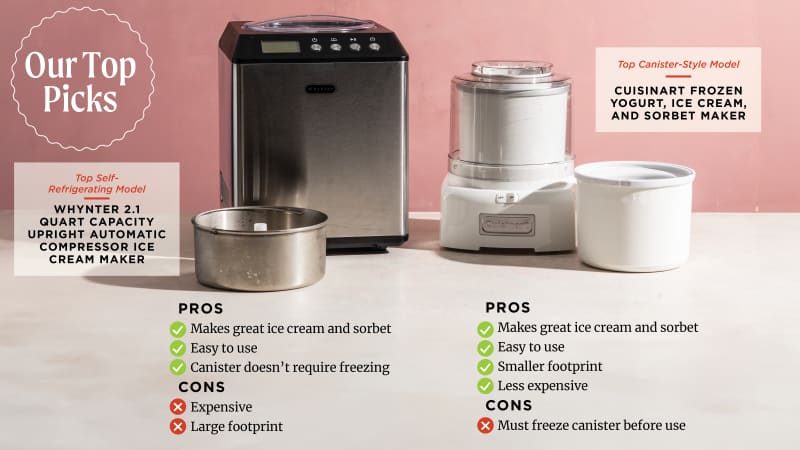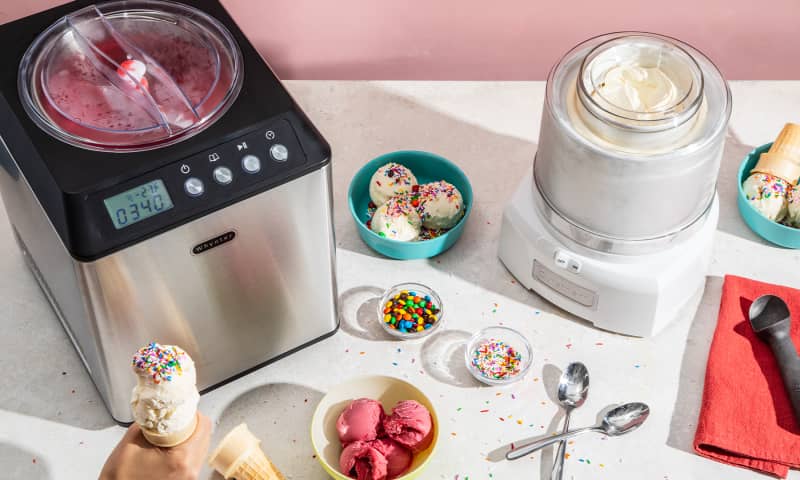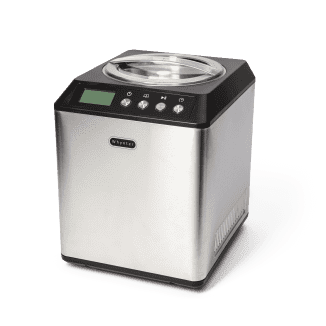A good electric ice cream maker makes it easy to produce customized ice cream, frozen yogurt, or sorbet at home. The machines come in two main styles: canister-style and self-refrigerating. The former has a removable coolant-lined canister that must be frozen before use. Self-refrigerating machines are generally much pricier, with built-in compressors that chill the canisters so there’s no need for prefreezing. When we discovered that the top self-refrigerating model from our 2010 testing had been discontinued, we knew it was time for an update. We rounded up a variety of ice cream makers: some canister-style (one of which was an attachment for our favorite KitchenAid stand mixer) and some self-refrigerating. We churned vanilla ice cream, coffee-crunch ice cream, raspberry sorbet, and frozen yogurt in each machine.

All ice cream makers work in a similar fashion. First, you make a loose dairy or fruit base and pour it into the machine. Then, through a combination of cooling and constant-yet-gentle churning, the machines transform the base into a thick, creamy dessert. The churning incorporates a small amount of air that is crucial to a smooth, semisoft consistency—without the air, the bases would freeze into hard bricks. Once the base has thickened to the consistency of a milkshake or soft-serve ice cream, it is transferred to a clean container and placed in the freezer for a brief firming-up period. Working quickly is crucial when churning and transferring the dessert to minimize the formation of large ice crystals and prevent accidental thawing.

Some of the machines required repeated intervention on the part of the user, while others were completely hands-off—and much of this came down to paddle design. The paddles came in a range of designs, with blades and bars designed to scrape the sides of the bowls while churning. Some had horizontal bars that spun just above the contents of the bowls; ice cream tended to clump up on these and ride around on top, forcing us to stop the ice cream makers every few minutes and push it back into the mixing action.

Another complaint: In the test kitchen, we gauge doneness with visual cues and by taking the temperature of the mixture. The tall horizontal blades got in the way of our thermometer probe, again forcing us to pause the machines. Since repeated disruptions to the cooling and churning process encourages the development of ice crystals, we much preferred paddle designs that allowed us access while the mixture churned.

When it came time to sample all the ice cream, frozen yogurt, and sorbet we’d made, we were pleasantly surprised to find that all of the samples ranged from good to great (since the machines don’t impact flavor, we were rating each product solely on texture). A few of the machines produced desserts that had more noticeable ice crystals, but the best models made frozen confections that were as smooth and creamy as commercial premium ice creams. All samples emerged from the freezer pleasantly dense and scoopable, neither too compact nor too airy, with mix-ins (when applicable) evenly distributed.

By the end of testing, we’d realized that each style of ice cream maker has inherent pros and cons. Both eat up counter space, with the canister-style machines having smaller footprints but requiring enough room in the freezer to freeze the canister—a step you have to remember to do at least 24 hours ahead. Canister-style machines also take less time to churn (averaging about 20 minutes versus about 30), but making consecutive batches requires purchasing and prefreezing additional bowls; self-refrigerating machines can keep going after pausing only to rinse and dry the bowl.

The Cuisinart Frozen Yogurt, Ice Cream & Sorbet Maker again earned top marks among canister-style machines. Its frozen desserts scored highly in our blind tastings, it was very easy to use, and it was one of the quickest machines in our lineup. For ice cream fanatics who are willing to spend more for the ability to make consecutive batches, we recommend the Whynter 2.1 Quart Capacity Upright Automatic Compressor Ice Cream Maker. It was the fastest self-refrigerating model we tested and yielded incredibly smooth ice cream and sorbet. No matter which you choose, you’ll be screaming not just for ice cream but for frozen yogurt and sorbet, too.
- Quick mixing
- Easy assembly
- Paddles with open tops and low blades that submerged fully in the mixture and let us take temperature readings during mixing
- Easy to clean, with few crevices and simple parts




















